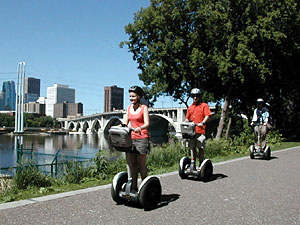|
Audio
Photos
Resources
Your Voice
|
Reinventing the wheel?
July 5, 2004
 |
| The Segway was perhaps the most eagerly awaited and wildly hyped product since the Apple Macintosh. Today it's being used to enhance sightseeing tours in Minneapolis. (Nikki Tundel ) |
Minneapolis, Minn. — According to the brochures, the Magical History Tour is an educational exploration of the Minneapolis riverfront. And while the area's attractions are indeed remarkable, guide Bill Neuenschwander admits the most striking sight on this tour has got to be the tour group itself.
"Foreigners snap pictures like crazy," says Neuenschwander.
 | |||
Sure, the Stone Arch Bridge is impressive. And it's hard to deny the allure of St. Anthony Falls. But those Twin Cities favorites just can't compete with the spectacle of 14 people in protective headgear riding down the sidewalk on what appear to be push lawnmowers.
"It's a pretty unusual sight," explains Neuenschwander.
Traveling in a linear formation typically employed by ducklings or parade floats, this tour group uses Segway Human Transporters to get from one attraction to the next. Perched atop these two-wheeled, self-balancing scooters, riders can propel themselves up to 12 miles an hour simply by leaning forward. Their movements may be eye-catching, but they certainly don't impress the passing bicyclists and inline skaters.
"There is no effort on your part. That's a machine for lazy people," says one bicyclist.
In this increasingly sedentary society, a device that rewards those who excel at merely standing upright can't help but attract criticism. And tour guide Eryn Dwey has heard it all.
"They say, 'Oh, you're so lazy. Why don't you just walk?' and 'You're all geeks. You're nerds,'" says Dwey." But I can take the abuse. It's worth it to be on a Segway."
 | |||
Like Dwey, Bill Neuenschwander takes the negative comments in stride. The Bloomington businessman is the president of Mobile Entertainment, the company that conducts the Segway-powered sightseeing trips. The way he sees it, the much mocked machine lets him showcase more of the city and increase his customer base. While walking tours are usually limited to five blocks, the Segway makes it possible for even the most out of shape sightseer to cover more than five miles.
"There isn't a walking tour, there isn't a trolley tour, there isn't a bus tour or anything else that's getting people up close to this kind of content," explains Neuenschwander.
Neuenschwander is the consummate pitchman. He sports a bright yellow T-shirt with the phrase 'Glide Me' printed across the front - which, thankfully, turns out to be an advertisement for the Segway. In no time, this guy can convince a whole room of people that it's classy to zip about town on a device that's best been described as a 'pogo stick with wheels.'
"People said it was like being on a magic carpet," says Neuenschwander.
 | |||
It's tempting, of course, to point out that magic carpets don't actually exist. But, then again, a 70-pound piece of metal that uses gyroscopes and tilt sensors and microprocessors to mimic the human body's ability to balance seems equally unreal.
"It feels almost like I'm a helicopter pilot on the ground," says one rider. "I know that doesn't make sense since I've never flown a helicopter. I've only imagined what it's like. But it feels like I'm kind of controlling movement in ways that I shouldn't be able to."
It cost over $100 million to develop the Segway. So far, one of its biggest accomplishments has been the enhancement of sightseeing trips.
With a little practice, it's possible to get this hi-tech scooter to do doughnuts on a 45-degree incline. And for people like Eryn Dwey, that's good enough.
"I would never want to go anywhere without out one," says Dwey.
And if it can help her get tour groups from one destination to the next without breaking a sweat, all the better.
|
News Headlines
|
Related Subjects
|
